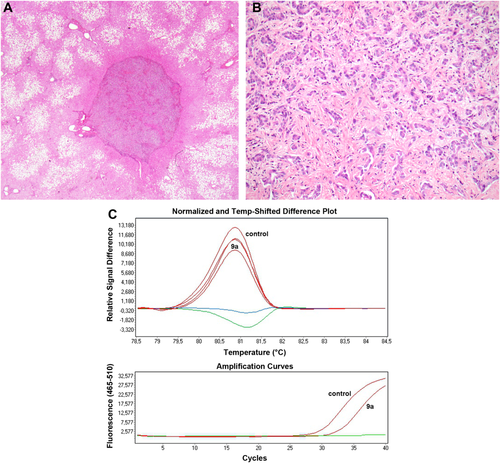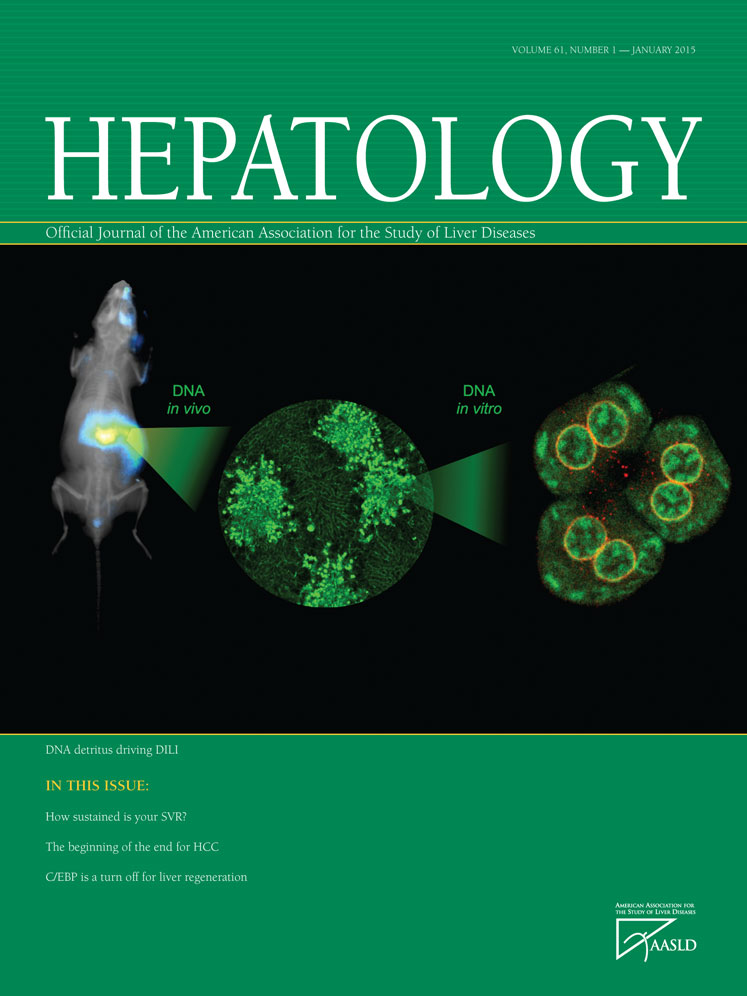BRAF V600E mutations in bile duct adenomas
Potential conflict of interest: Nothing to report.
Bile duct adenomas (BDA) are rare and benign intrahepatic biliary proliferations of uncertain pathogenesis. They are usually small in size (<5 mm) and incidentally discovered during intraabdominal surgery or macroscopic examination of surgical specimens.
Histologically, they consist of numerous and small bile ducts interspersed with fibrous stroma (Fig. 1A,B). These lesions are frequently referred to as “peribiliary gland hamartomas,”1 and some authors have also proposed that they might represent a focal ductular proliferation developed in response to liver injury.2 Their reactive versus neoplastic nature, however, is still debated; nevertheless, malignant transformation into intrahepatic cholangiocarcinoma (ICC) has been reported.3, 4

We screened a series of 15 BDAs for BRAF mutations to determine if this oncogene, mutated in various benign neoplasms, is involved in their development. These BDAs were observed in 10 patients, among whom four had an associated intrahepatic cholangiocarcinoma (ICC) (Table 1). Genomic DNA was extracted from formalin-fixed paraffin-embedded blocks with Qiagen robot EZ1. Samples were screened for BRAF (codon 600) mutations by means of high-resolution melting analysis and mutant DNA were further analyzed with an allele-specific polymerase chain reaction assay (ENTROGEN).
| Patient No. | Age | Gender | Indication of Liver Surgery | Liver Disease | Number of BDA | Tumor ID | Tumor Histological Diagnosis | BRAF Mutational Status |
|---|---|---|---|---|---|---|---|---|
| 1 | 56 | F | Metastatic colorectal carcinoma | None | 2 | 1a | BDA | V600E |
| 2 | 59 | M | ICC | None | 2 | 2a | BDA | wt |
| 2b | BDA | wt | ||||||
| 2c | ICC | wt | ||||||
| 3 | 65 | M | HCC | NASH | >3 | 3a | BDA | wt |
| 4 | 62 | M | Atypical focal nodular hyperlasia | NASH | 2 | 4a | BDA | V600E |
| 4b | BDA | wt | ||||||
| 5 | 67 | M | ICC | None | 3 | 5a | BDA | V600E |
| 5b | BDA | V600E | ||||||
| 5c | BDA | V600E | ||||||
| 5d | ICC | V600E | ||||||
| 6 | 57 | M | HCC | NASH/Alcohol | 1 | 6a | BDA | wt |
| 7 | 76 | M | ICC | None | >3 | 7a | BDA | wt |
| 7b | ICC | wt | ||||||
| 8 | 74 | M | Biliary cyst | None | 1 | 8a | BDA | V600E |
| 9 | 69 | M | ICC | None | 2 | 9a | BDA | V600E |
| 9b | BDA | V600E | ||||||
| 9c | ICC | V600E | ||||||
| 10 | 63 | F | Pancreatic endocrine tumor | None | 1 | 10a | BDA | wWt |
- Wt, wild-type; HCC, hepatocellular carcinoma; NASH, nonalcoholic steatohepatitis.
BRAF V600E mutations were identified in 8/15 (53%) BDAs (Table 1). The existence of a recurrent molecular alteration such as a BRAF mutation strongly supports the hypothesis that BDAs are true neoplasms and that they should no more be designated as reactive processes or hamartomas. Moreover, V600E mutations were also identified in two out of the four ICC associated with BDA (Table 1). As the BRAF mutation rate in ICC is rather low (5-10%),5 this observation suggests that BRAF mutated ICC might arise from BDA. BRAF mutations also seem to occur early during carcinogenesis, as observed in the serrated pathway of colon cancer.6
In conclusion, we have identified a high frequency of BRAF V600E mutations in BDAs, suggesting that they are true neoplasms and that they may be important precursors for the subset of ICC exhibiting BRAF mutations. Our findings support an adenoma to carcinoma sequence associated with BRAF mutations in intrahepatic biliary carcinogenesis.
Acknowledgment
The authors thank Morgane Fontaine, Simon Auneau, Caroline Taou, Deborah Siroli, Soraya Mehdaoui, Emilie Gelabale for technical assistance; and Tumorotheque/Plateforme Ressources Biologiques of Henri Mondor University Hospital, Tumor Bank of CHU Bordeaux, and Reseau des CRB foie-Inserm for contributing to the tissue collection.
-
Anaïs Pujals, Ph.D.1-3
-
Giuliana Amaddeo, M.D., Ph.D.2-4
-
Claire Castain, M.D.5,6
-
Paulette Bioulac-Sage, M.D.5,6
-
Philippe Compagnon, M.D.7
-
Jessica Zucman-Rossi, M.D., Ph.D.8
-
Daniel Azoulay, M.D., Ph.D.7
-
Karen Leroy, M.D., Ph.D.1-3
-
Elie Serge Zafrani, M.D.1,2
-
Julien Calderaro, M.D.1,2
-
1Assistance Publique-Hôpitaux de Paris
-
Department of Pathology
-
Créteil, France
-
2Université Paris-Est Créteil
-
Faculté de Médecine
-
Créteil, France
-
3Inserm U955
-
Institut Mondor de Recherche Biomédicale
-
Créteil, France
-
4Assistance Publique-Hôpitaux de Paris
-
Department of Hepatology
-
Créteil, France
-
5CHU de Bordeaux
-
Pellegrin Hospital
-
Department of Pathology
-
Bordeaux, France
-
6Inserm UMR-1053
-
Université de Bordeaux
-
Bordeaux, France
-
7Assistance Publique-Hôpitaux de Paris
-
Department of Digestive and Hepatobiliary Surgery
-
Créteil, France
-
8Inserm UMR-1162
-
Génomique fonctionnelle des tumeurs solides, IUH
-
Paris, France




